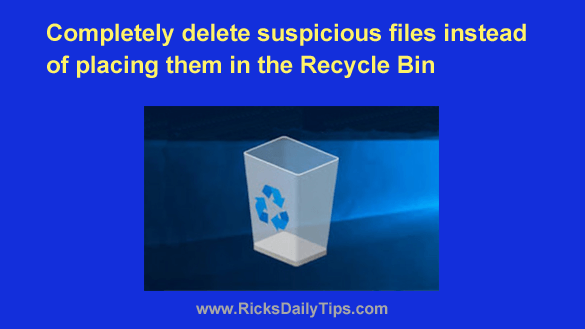
Want to get my easy to follow Tech Tips in your email?
Sign up for my daily Rick’s Tech Tips Newsletter!
If you’ve been using Microsoft Windows for a while you probably know that deleting a file doesn’t really remove it from the system.
Instead, it’s actually moved to a special folder called the Recycle Bin.
That’s generally a good thing because we all occasionally delete a file by mistake or wish we hadn’t deleted a file at some later point in time.
Having our deleted files go into the Recycle Bin makes it easy to restore one of them to it’s original folder in either of the above-mentioned cases.
But unfortunately some files can become problematic if we allow them to sit idly in the Recycle Bin.
Files that are infected with malware like viruses and worms can lurk in the Recycle Bin and wait to spring into action when triggered by another malicious piece of software, a flaw in one of the programs we run, or even a flaw in the Windows code itself.
That’s why it’s a bad idea to simply delete files that you believe could possibly be malicious.
Instead, it’s best to remove them from the system immediately instead of allowing them to be tossed into the Recycle Bin.
Luckily, this is very easy to do. Instead of simply pressing the “Delete” key, press the Shift+Delete key combination instead.
Pressing Shift+Delete will immediately remove a potentially dangerous file from your system instead of placing it into the Recycle Bin where it could possibly spring to life at a later time and wreak all kinds of havoc with your system.
And there’s another option as well…
If you’re one of the relatively few people who never use the Recycle Bin at all you can effectively disable it so that EVERY file you delete is removed from the system instead of being placed in the Recycle Bin. And it’s very easy to do…
Follow these steps if the Recycle Bin icon is displayed on the Desktop:
1 – Right-click on the Recycle Bin icon and then click Properties.
2 – Select the line that says Don’t move files to the Recycle Bin. Remove files immediately when deleted.
3 – Click Apply, then click OK.
Follow these steps if the Recycle Bin icon isn’t displayed on the Desktop:
1 – Right-click on the Start button and select Settings from the menu.
2 – In the left-hand pane, click Personalization.
3 – In the right-hand pane, click Themes.
4 – Click Desktop icon settings.
5 – Check the box beside Recycle Bin, then click Apply. The Recycle Bin should now be visible on the Desktop.
6 – Right-click on the Recycle Bin icon and then click Properties.
7 – Select the line that says Don’t move files to the Recycle Bin. Remove files immediately when deleted.
8 – Click Apply, then click OK.
That’s all there is to it. From now on when you delete a file it’ll be immediately removed from the system instead of being placed in the Recycle Bin.
Bottom line: It’s never a good idea to allow Windows to place potentially malicious files into the Recycle Bin. It’s best to always delete them outright using one of the methods mentioned above.